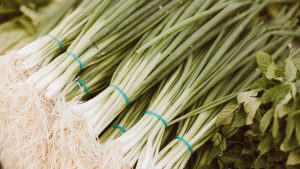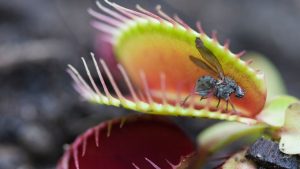Last Updated on March 26, 2025 by teamobn
The whole world is right now going nuts over almonds. People have been cultivating – and consuming – the coveted tree crop for some 6,000 years. Yet there are no indications that it’s going to drop out of fashion any time soon.
In fact, from marzipan, to candy, to the growing interest in almond “milk” products, people are devouring more almonds now than ever before.
Growing out of the same family as peaches, apricots, cherries, and plums, almonds are a wonderfully nutritious addition to any backyard garden.
Some experts have argued that the almond is the single most nutritious food you can eat. Research shows that eating almonds can help with weight loss and satiety, prevent diabetes, inhibit cancer-cell growth, and decrease the risk of Alzheimer’s disease.
The almond tree produces spectacular blossoms, too, before filling out with foliage in early spring. The flowers are a blush of pinkish white. They are quite fragrant and they usually form along the shorter lateral branches. Each flower has at least five wondrously delicate petals.
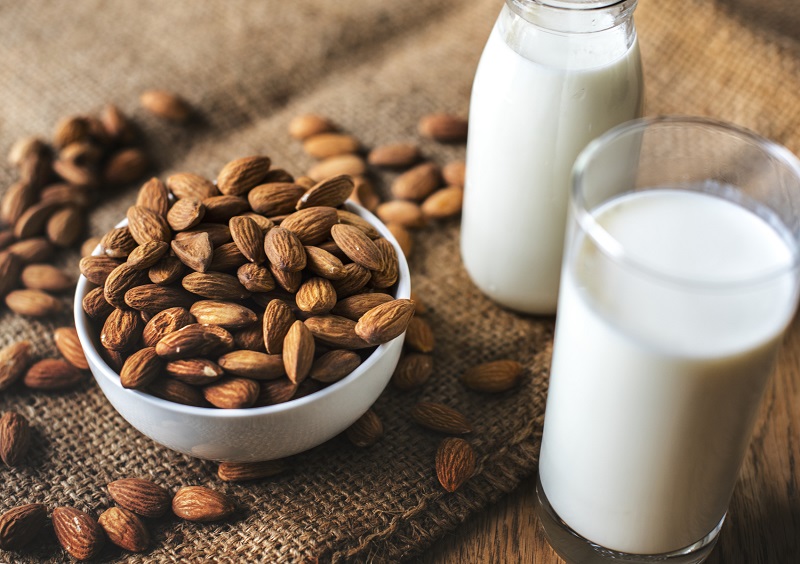
Where Almond Trees Thrive
Contents
The almond tree is native to Iran and its surrounding landscape. Today, however, 82 percent of the world’s almonds come from California. The tree also grows in Southeastern states, Texas, the coastlines of Washington, Oregon, all the way up the coast to Massachusetts in the east.
In Australia, farmers and gardeners grow almonds westward from the Riverina region to Sunraysia, Riverland Northern Adelaide Plains, and the Swan region in Western Australia.
But with good soil drainage and cold winters, the tree will grow all the way north to Toowoomba, Charleville, and even Central Australia.
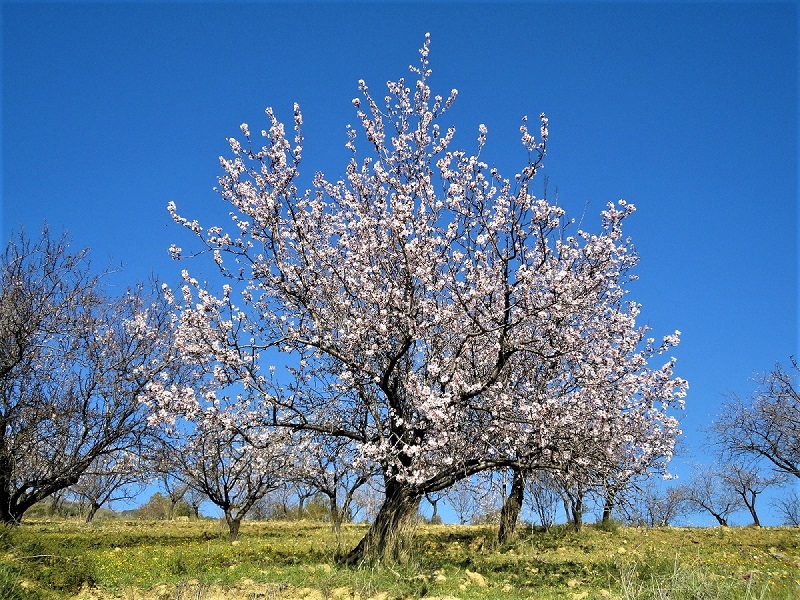
Choosing an Almond Cultivar
When choosing your tree, the most important things to keep in mind are the growing conditions. The almond tree requires hot and dry conditions and will thrive in areas that have long summers with hot, dry, sunny weather.
The tree prefers well-drained, deep, loamy soils but will tolerate other soil types, including poor soils, as long as conditions are not too wet.
There are quite a few standard varieties, including ‘Carmel,’ which offers an excellent, well protected nut. The ‘Mission’ is a late bloomer but is an exceedingly productive tree once fully mature.
That said, most experts agree that the ‘All-In-One’ variety is the best for backyard growers as it only grows to about half the size of a typical tree. This makes this particular almond cultivar ideal for home orchards.
The ‘All-In-One’ almond variety is also exceptional as it’s among the few self-pollinating cultivars. You don’t need to grow two trees to produce fruit.

Planting Your Almond Tree
For best results, start your tree from a sapling. Plant the sapling around 15 to 20 feet from its nearest neighbor, in full sun and in well-draining soil.
Remember, if too much water accumulates around the roots, the tree is likely to suffer root rot. To prevent this, add some humus-rich sandy loam into the soil. This type of soil tends to absorb excess moisture.
Dig a hole in the ground large enough to accommodate the roots. Carefully set the sapling into the hole, making sure you don’t bend or damage the main taproot.
Be careful when placing your almond tree into the ground. To transplant a potted tree, plant it at the same depth it was planted in the pot.
Clear the base of the tree to prevent competition from weeds and other plants. Mulch the area well to ensure sufficient moisture and keep weeds at bay.
Once you’ve filled the hole up three-quarters deep, add two buckets of water. Experts suggest you add some fertilizer to the second bucket. You should also add some enhanced soil. Tap the soil with a shovel as you add each pile of dirt.
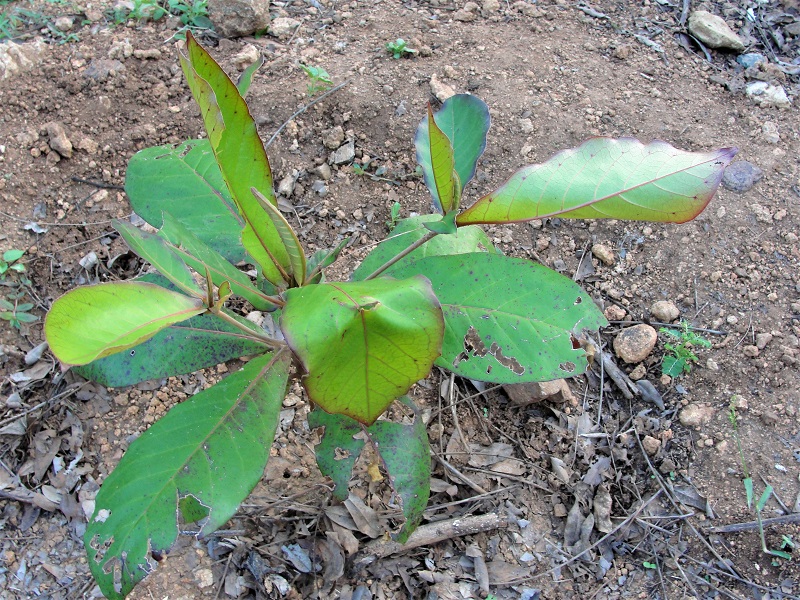
Pruning
You can begin pruning your tree once it’s firmly established. Don’t hold back. Pruning young almond trees determines their future shape, their productivity, and the quality of the nuts they produce.
Heavy pruning will help your tree develop a strong root system. You can safely cut back a third to one-half of the young tree’s twigs and branches.
The almond tree is commonly pruned into a “vase” shape with three or four main branches, which also allows for easy harvesting. When done correctly, the shape makes the tree more vigorous and productive even as it ensures a longer lifespan.
Pruning a mature tree, however, is more about maintaining the shape established earlier in the tree’s life. Pruning reinvigorates the tree and stimulates fruiting. You should aim to prune around 20 percent of an older tree’s canopy each year.
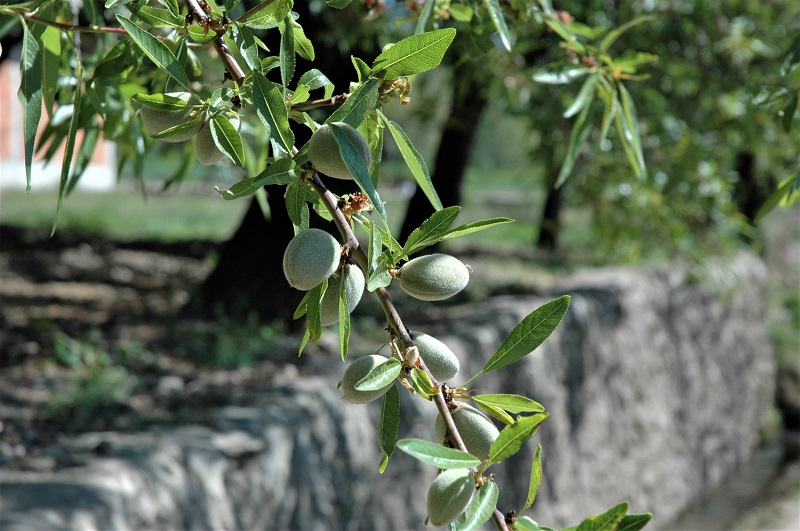
Harvesting Almonds
What we call almond nuts are actually the seed of a fruit from the almond tree. The almond tree begins to produce this fruit around three years after planting.
In Australia, the harvest season falls between February and April, when the ‘nut’ is at an acceptable moisture level. The almond harvest season in the US meanwhile runs from August through October.
Monitor your almond tree daily during the harvest season. Inspect all the almonds you can see from the ground, checking the hulls for signs of splitting.
Almonds begin ripening at the top of the tree, working their way downward. This means the nuts at eye level aren’t as ripe as those at the top.
Harvest your almonds when 90 percent of the hulls on the tree have split open to expose the shells inside. Start a little sooner, if necessary, to keep birds from making off with your crop.
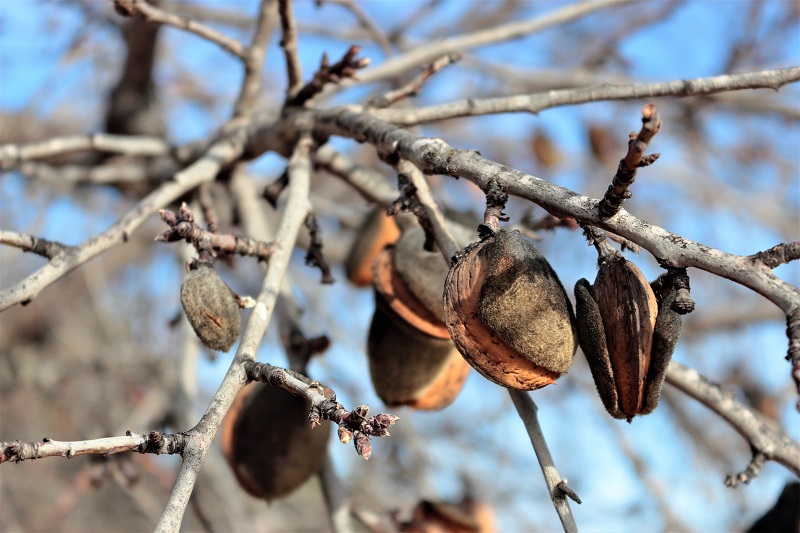
To harvest the almonds, shake the tree, then separate the hulls from the nut. Store your harvest in plastic bags. Freeze the almond nuts for one to two weeks to kill any worms.
So, are you ready to grow your own almond tree?
Soil and Climate Requirements in Detail
Growing a healthy almond tree begins with the right foundation. That means knowing what kind of soil it prefers and what climate conditions allow it to thrive. While almond trees are known for their resilience, they still need specific care when it comes to temperature, sun exposure, and soil quality. If your goal is a strong, productive tree that produces quality nuts, paying attention to these basics is essential.
Climate Conditions for Growth
Almond trees love warm, dry climates. They’re naturally adapted to Mediterranean-like weather patterns. That means hot summers and cool winters work best. A period of winter dormancy is actually necessary. Without it, the tree won’t flower properly and nut production will suffer. Cold temperatures help reset the tree’s natural growing cycle. At the same time, almond trees don’t tolerate extreme frost well, especially when young. Late spring frosts can damage the delicate blossoms and impact fruit set.
If you live in a region with mild, wet winters and long dry summers, you’re already in a good spot. Areas like inland California, southern Australia, and parts of the Mediterranean region offer ideal growing conditions. But that doesn’t mean growers in other zones are out of luck. In cooler regions, choose a cultivar that requires fewer chilling hours and plant in a protected spot with good sun exposure.
Sunlight is also non-negotiable. Almond trees need full sun to grow and produce fruit. Aim for a location that gets at least six hours of direct sunlight daily. More is better. Shade will weaken the tree over time and reduce yield.
Soil Preferences and Preparation
The almond tree has a strong root system that needs room to spread. This makes soil structure a top priority. Well-drained soil is critical. Almond trees do not tolerate standing water. If the roots sit in wet conditions for too long, they become susceptible to root rot and fungal disease. Heavy clay soils with poor drainage are a common cause of failure for backyard growers.
Almonds grow best in sandy loam soils that are deep and rich in organic matter. This type of soil holds nutrients but still drains well after rainfall or watering. If your soil is compacted or has poor structure, work in plenty of compost or well-rotted manure before planting. This helps improve aeration and drainage. Raised beds are also a smart option for improving drainage in stubborn soils.
As for pH, almonds prefer slightly acidic to neutral soil, ideally between 6.0 and 7.0. You can test your soil with an inexpensive home testing kit. If the pH is too low, add lime to raise it. If it’s too high, incorporate sulfur or organic materials like pine needles to lower the pH gradually.
A Healthy Start for Long-Term Growth
Getting the climate and soil right at the start can save years of frustration. With full sun, well-drained soil, and the right winter conditions, your almond tree will be well-positioned to grow strong and produce abundant nuts. Think of it as setting the stage. The better the soil and climate match your tree’s natural needs, the more successful your almond-growing experience will be.
Common Almond Tree Pests and Diseases
Even the healthiest almond trees can fall prey to pests and diseases. Knowing what to look for—and how to respond—can make all the difference. Early detection and good care practices help prevent small problems from turning into major setbacks. Here are the most common threats almond growers face and how to manage them effectively.
Navel Orangeworm
This is one of the most destructive pests for almond trees. The adult moth lays its eggs on damaged nuts or leftover hulls from a previous harvest. Once the larvae hatch, they burrow into the nut and feed on it, ruining your crop. Worse, they often bring mold with them, which further contaminates the tree.
To control them, clean up fallen nuts promptly. Remove mummies—those dried, leftover nuts—still clinging to branches at the end of the season. You can also use pheromone traps to monitor their activity and time insecticide treatments more effectively if needed.
Peach Twig Borer
This pest targets new shoots and young almonds. The larvae bore into soft twigs and fruit, causing dieback on fresh growth and early fruit drop. Trees with a heavy infestation can suffer serious damage to their yield and overall shape.
Dormant oil sprays applied during the winter can help kill overwintering eggs. In spring, monitor the tree for signs of chewing or wilting shoots. Prune affected branches to reduce their spread. If needed, apply a targeted insecticide in early bloom or pre-harvest.
Aphids
Aphids are small, soft-bodied insects that feed on plant sap. They often cluster on new leaves and stems, causing leaf curl and sticky residue known as honeydew. This residue attracts ants and can lead to sooty mold, which interferes with photosynthesis.
Introduce beneficial insects like ladybugs or lacewings to keep aphid populations in check. You can also spray the tree with a strong blast of water to knock aphids off. For persistent cases, use insecticidal soap or neem oil early in the morning or late in the day.
Shot Hole Disease
Caused by a fungal pathogen, this disease creates small reddish spots on leaves that eventually fall out, giving a shot-hole appearance. Severe infections can lead to leaf drop, defoliation, and weakened growth. The fungus also affects twigs and young fruit.
Prevent shot hole disease with proper spacing and pruning for airflow. Avoid overhead watering. Copper-based fungicides can be applied in the dormant season and again during early leaf development if symptoms persist.
Rust
Rust appears as yellow or reddish-orange spots on the underside of leaves. Infected leaves may fall prematurely, which weakens the tree’s energy reserves for the following season. The disease spreads quickly in wet or humid conditions.
Remove and destroy fallen leaves to prevent it from overwintering. Improve airflow through careful pruning. Fungicidal sprays may be needed if the tree experiences repeated outbreaks year after year.
Keeping Pests in Check
The key to managing almond pests and diseases is consistent observation. Walk around your tree regularly. Look at the leaves, twigs, and nuts. A little prevention goes a long way. Keep your garden clean, prune when needed, and act quickly when something looks off. That’s how you keep your almond tree productive and healthy season after season.
Conclusion
Growing an almond tree at home is a rewarding process that offers both beauty and bounty. With the right conditions and care, your tree can thrive for decades. From spring blossoms to fall harvest, each season brings something valuable to enjoy.
We have more rewarding plants to cultivate for your garden. Check out our mini fruit orchard guide!

